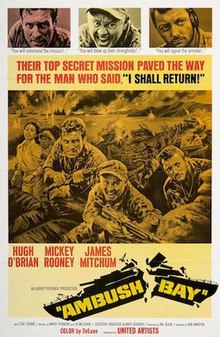Plot
Prior to the 1944 American invasion of the Philippines a hand-picked team of U.S. Marine Corps amphibious reconnaissance scouts is landed by a PBY Catalina with the mission of contacting an intelligence agent who has crucial information. Each Marine is not only experienced but has a special skill with the exception of the radio operator, PFC Grenier (James Mitchum).
Grenier, an air crew radioman with only six months in the Corps is taken off the PBY's air crew when the original radio operator suddenly became medically unfit for the mission. He is given the sick Marine's radio and camouflage jacket to carry on his first ground combat mission. He serves as a narrator to the audience.
After meeting up with their guide (Manual Amado), the patrol commander Captain Alonzo Davis (Lieutenant Colonel Clement J. Stadler who had been awarded the Navy Cross [1] and who also acted as the film's technical advisor) is killed while ambushing a small group of Japanese soldiers, and First Sergeant Corey (Hugh O'Brian, recognized as one of the youngest Drill Instructors to have served in the USMC [2] ) takes command.
Pvt. George George and Pfc. Henry Reynolds are killed while taking out a Japanese tank and patrol. Cpl. Stanley Parrish (Greg Amsterdam, the son of Morey Amsterdam) is killed by a guerrilla trap soon after. As they walk on, Amado is shot by a Japanese officer while scaling a small hill. The marines let him die to keep their presence secret. Grenier is eventually told by Gunnery Sergeant Wartell (Mickey Rooney) that they were sent to recover some important information from a contact in a tea house whose radio was destroyed, thus explaining the radio's importance to the mission.
Grenier's inexperience and incompetence arouses anger amongst Corey and the other members of the patrol. His only friend is easy going but professional Gunnery Sergeant Wartell who acts as a mediator between the hard no nonsense 1st Sgt Corey and Grenier, explaining each one to the other and the audience. Rooney provides the only comedy relief in the film when his character is captured and interrogated by a group of careless Japanese soldiers.
The surviving squad members eventually arrive at the tea house but, unfortunately, Amado was the one who was supposed to meet the contact as he was the only Filipino in the group. Desperate, Corey decides to meet the contact, Miyazaki a Japanese-American woman from Long Beach, California. While sneaking out of the camp with Miyazaki, Corey crashes into a waiter and the two run across a straw bridge then blow it up with a grenade, escaping from the soldiers. Meanwhile, a large skirmish with a Japanese patrol has killed Cpl. Alvin Ross and Platoon Sergeant William Maccone, shot the radio up beyond repair, and wounded Gunnery Sergeant Wartell. Wartell, knowing he will slow the survivors down, tells the reluctant Corey to leave him behind. When they leave, he plants grenades under himself and is captured by the Japanese soldiers. After toying with them a bit during his interrogation he sets off the grenades, taking them all out in the blast, and leaving Corey and Grenier the only surviving marines. The explosion is heard by the survivors and they sadly track on.
Corey and Grenier learn from Miyazaki that the Japanese are expecting the invasion fleet and have placed a mine field powerful enough to destroy the entire fleet in the water around the invasion sites. Arriving at a friendly Filipino village, Corey and Grenier are able to escape a Japanese patrol by boat. But Miyazaki is killed by an officer she seduced to buy the guys some time. At last discovering the principles of mission accomplishment, altruism, and self-sacrifice through observation, Grenier becomes a squared away Marine. He and his First Sergeant infiltrate the enemy base to remotely detonate the minefield with the Japanese radio transmitter. As Corey provides a one-man army diversion, Grenier is able to detonate the mines by radio control. Grenier then steals a radio and goes to tell Corey of their success, only to find Corey dead of blood loss from wounds he got while holding off the Japanese, leaving Grenier the sole survivor of the mission. Grenier escapes to the coast and radios for pick up. The movie ends with Grenier looking at the ocean while he listens to a speech by General MacArthur as he awaits pick up.

The Phil Silvers Show, originally titled You'll Never Get Rich, is a sitcom which ran on CBS from 1955 to 1959. A pilot titled "Audition Show" was made in 1955, but it was never broadcast. 143 other episodes were broadcast – all half-an-hour long except for a 1959 one-hour live special. The series starred Phil Silvers as Master Sergeant Ernest G. Bilko of the United States Army.

Harlon Henry Block was a United States Marine Corps corporal who was killed in action during the Battle of Iwo Jima in World War II.

Michael Strank was a United States Marine Corps sergeant who was killed in action during the Battle of Iwo Jima in World War II. He was one of the Marines who raised the second U.S. flag on Mount Suribachi on February 23, 1945, as shown in the iconic photograph Raising the Flag on Iwo Jima by photographer Joe Rosenthal. Of the six Marines depicted in the photo, Strank was the only one to be correctly identified from the beginning; the other five were either assigned the wrong locations, or, were given the names of Marines who were not in the photo.

A Walk in the Sun is a 1945 American war film based on the novel by Harry Brown, who was a writer for Yank, the Army Weekly based in England. The book was serialized in Liberty Magazine in October 1944.

Windtalkers is a 2002 American war film directed and co-produced by John Woo, starring Nicolas Cage, Adam Beach, Peter Stormare, Noah Emmerich, Mark Ruffalo, and Christian Slater. It is based on the real story of Navajo code talkers during World War II. C. O. Erickson was the executive producer. The film was released in the United States on June 14, 2002, and received mixed reviews and proved to be financially unsuccessful, grossing just $77.6 million worldwide against a production budget of $115 million.
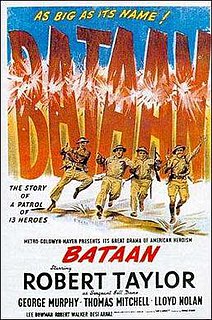
Bataan is a 1943 American black-and-white World War II film drama from Metro-Goldwyn-Mayer, produced by Irving Starr, directed by Tay Garnett, that stars Robert Taylor, George Murphy, Lloyd Nolan, Thomas Mitchell, Desi Arnaz and Robert Walker. It follows the fates of a group of men charged with destroying a bridge during the doomed defense of the Bataan Peninsula by American forces in the Philippines against the invading Japanese.

The United Kingdom was one of the first countries to take part in Operation Enduring Freedom against the Taliban regime in autumn 2001.
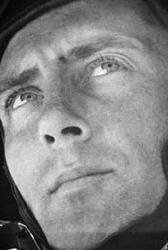
Henry Oliver Hansen was a United States Marine Corps sergeant who was killed in action during the Battle of Iwo Jima in World War II. He was a member of the patrol that captured Mount Suribachi, where he helped raise the first U.S. flag on Iwo Jima on February 23, 1945. He was killed six days later.
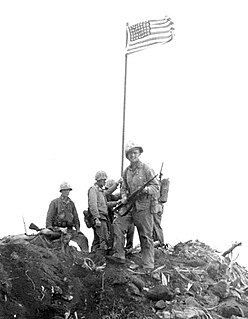
Ernest Ivy "Boots" Thomas Jr. was a United States Marine Corps platoon sergeant who was killed in action during the Battle of Iwo Jima in World War II. He was awarded the Navy Cross for extraordinary heroism while fighting for and at the base of Mount Suribachi. Two days later he was a member of the patrol that captured the top of Mount Suribachi where he helped raise the first U.S. flag on Iwo Jima on February 23, 1945. He was killed eight days after that.
Harold George Schrier was a United States Marine Corps lieutenant colonel who served in World War II and the Korean War. In World War II, he was awarded the Navy Cross for leading the patrol that captured the top of Mount Suribachi, where he helped raise the first U.S. flag on Iwo Jima on February 23, 1945. In the Korean War, he was wounded in North Korea during the Battle of Chosin Reservoir while commanding a rifle company.
The Walking Dead is a 1995 war film written and directed by Preston A. Whitmore II and starring Allen Payne, Joe Morton and Eddie Griffin. The film depicts the lives of five Marines who are all assigned to rescue a group of POW during the Vietnam War in 1972. It opened to poor reviews and low box office receipts. Previews billed it as "the black experience in Vietnam".

Cease Fire! is a 1953 war movie directed by Owen Crump. The film featured real ammunition and real soldiers that were filmed on location in Korea, and was the first 3D war movie filmed in an actual theatre of operations.

None but the Brave is a 1965 war film directed by Frank Sinatra, with special effects by Eiji Tsuburaya. It was the first film international co-production between Japan and the United States. Filmed in Panavision.
Charles W. Lindberg was a United States Marine Corps corporal who fought in three island campaigns during World War II. During the Battle of Iwo Jima, he was a member of the patrol that captured the top of Mount Suribachi where he helped raise the first U.S. flag on the island on February 23, 1945. Six days later, he was wounded in action.
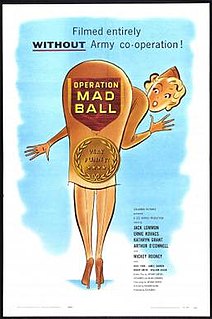
Operation Mad Ball is a 1957 military comedy from Columbia Pictures, produced by Jed Harris, directed by Richard Quine, that stars Jack Lemmon, Ernie Kovacs, Kathryn Grant, Arthur O'Connell, and Mickey Rooney. The screenplay is by Blake Edwards, Jed Harris, and Arthur Carter, based on an unproduced play by Carter.
Gung Ho! is a 1943 American war film directed by Ray Enright and starring Randolph Scott. The story is based somewhat on the real-life World War II Makin Island raid led by Lieutenant Colonel Evans Carlson's 2nd Marine Raider Battalion.

Aerial Gunner is a 1943 American black-and-white World War II propaganda film produced by William C. Thomas and William H. Pine, who also directed. The film stars Chester Morris, Richard Arlen, and Jimmy Lydon. This was the first feature film directed by Pine, who produced other films through his company, Pine-Thomas Productions. Aerial Gunner was distributed by Paramount Pictures.
Screaming Eagles is a 1956 black-and-white World War II film directed by Charles F. Haas, released by Allied Artists, and starring Tom Tryon, Jan Merlin and, in her film debut, French Miss Universe 1954 runner-up Jacqueline Beer.

Desert Hell is a 1958 American adventure film directed by Charles Marquis Warren and written by Charles Marquis Warren and Endre Bohem. The film stars Brian Keith, Barbara Hale, Richard Denning, Johnny Desmond, Phillip Pine, Richard Shannon and Albert Carrier. The film was released on June 25, 1958, by 20th Century Fox.

Harold Henry Schultz was a United States Marine corporal who was wounded in action during the Battle of Iwo Jima in World War II. He was a member of the patrol that captured the top of Mount Suribachi and raised the first U.S. flag on Iwo Jima on February 23, 1945. He is one of the six Marines who raised the larger replacement flag on the mountaintop the same day as shown in the iconic photograph Raising the Flag on Iwo Jima.
